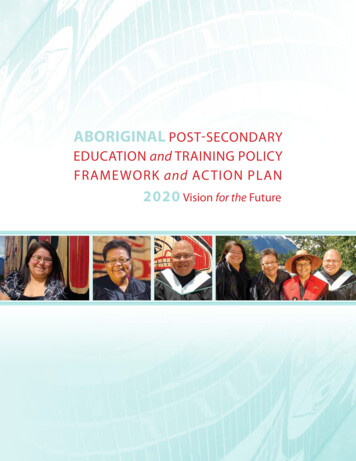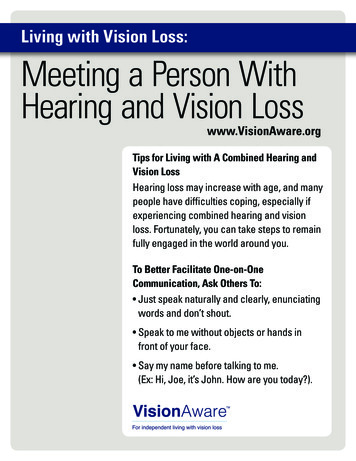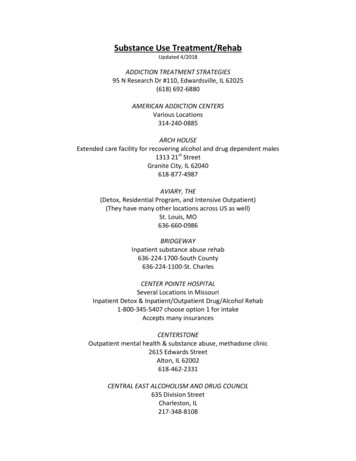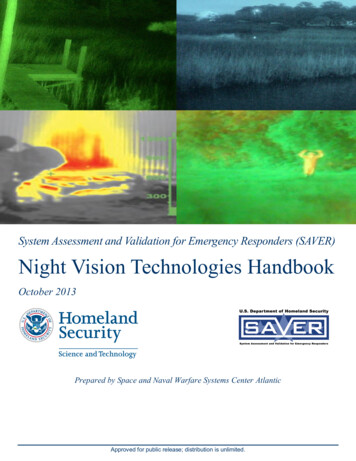
Transcription
ABORIGINAL POST SECONDARYEDUCATION and TRAINING POLICYFRAMEWORK and AC TION PLAN2020 Vision for the Future
Photo courtesy of: Thompson Rivers UniversityINTRODUC TIONPost-secondary education is key to unlocking the full potential of Aboriginal. 1British Columbians and their communities, and to British Columbia’s successas a province.British Columbia faces a decade of economic change, with over a million newjob openings. Due to changing demographics, a shortage of newly trainedskilled workers in British Columbia’s labour market is anticipated. First Nations,Métis and Inuit peoples are the fastest growing segment of British Columbia’spopulation. Investing in post-secondary education and training for FirstNations, Métis and Inuit peoples will help address forecast labour marketshortages, position Aboriginal British Columbians to take advantage ofthe economic opportunities that exist in the province, and enhance theirparticipation in the social, cultural and economic life of their communities,the province and global society. The benefits of post-secondary educationaccrue to individuals, communities and society, and are associated with1“Aboriginal” and “First Nations, Métis and Inuit” are used interchangeably in thisframework and are both used to be inclusive of all Aboriginal peoples in the province,whether or not they have status or have a connection to a particular community;recognizing that many peoples prefer the terms that are specific and traditionalto their communities.2020 VISION FOR THE FUTURE1
better labour market outcomes, better health outcomes, better outcomesfor children, lower crime rates, and higher levels of civic participation.2Photo courtesy of: Thompson Rivers UniversityThis Aboriginal Post-Secondary Education and Training Policy Frameworkand Action Plan outlines a plan for improving post-secondary opportunitiesand outcomes for First Nations, Métis and Inuit peoples. It sets out a Vision,Principles and Goals, informed by evidence-based policies and leadingpractices, to address systemic barriers and support systemic institutionalchange to support Aboriginal learners. The Framework places an emphasison several key program areas, but it is important to note the Frameworkis broad-based and encompasses all post-secondary education and trainingprograms, including adult basic education, vocational, career, business, trades,undergraduate and graduate degree programs.Consistent with commitments made in the New Relationship document,the Transformative Change Accord, and the Métis Nation Relationship Accord,this policy framework was developed by a working group of British Columbia’sAboriginal Post-Secondary Education Partners, including the First NationsEducation Steering Committee, the Indigenous Adult and Higher LearningAssociation, the Métis Nation BC, the First Nations Public Service, BC Colleges,BC Association of Universities and Institutes, and the Research Universities’Council of British Columbia.LEGAL CONTEXTThe Ministry of Advanced Education (AVED) is responsible for the legislationunder which the public post-secondary institutions operate includingthe University Act, College and Institute Act, Royal Roads University Act, and theThompson Rivers University Act. AVED is also responsible for the Private CareerTraining Institutions Act, which regulates private career training institutions.In addition, AVED is responsible for the Degree Authorization Act, whichestablishes a quality assessment and approval process for all institutionswishing to grant degrees in the province.Section 91(24) of the Constitution Act of 1867 provides the federal governmentwith exclusive jurisdiction for “Indians, and Lands reserved for the Indians”,while the provinces have exclusive jurisdiction over education undersection 93 of the same Act.Section 35 of the Constitution Act of 1982 states that the existing Aboriginaland treaty rights of the Aboriginal peoples of Canada are hereby recognizedand affirmed in which “Aboriginal peoples of Canada” includes the Indian,Inuit and Métis peoples of Canada.22Canadian Millennium Scholarship Foundation, “The Value of a Degree: Education,Employment and Earnings in Canada in The Price of Knowledge: Access and StudentFinance in Canada,” Joseph Berger and Andrew Parkin, undated, Chapter 1.ABORIGINAL POST - SECONDARY EDUCATION AND TRAINING POLICY FRAMEWORK AND ACTION PLAN
Photo courtesy of: Thompson Rivers UniversityDetermining jurisdiction over Aboriginal adult and post-secondary educationis complex. AVED is committed to engaging and working with the federalgovernment regarding the respective roles, responsibilities and contributionsof First Nations, Métis and Inuit peoples, the Government of Canada andthe Province as they relate to support for students and for Aboriginalcontrolled institutes.british columbia’scontinuing commitmentsThe New Relationship was a vision document signed in 2005between the provincial government and British Columbia FirstNations. It lays the groundwork for developing a new governmentto-government relationship based on respect, recognition andaccommodation of Aboriginal title and rights.The Transformative Change Accord was signed in November2005 by the Government of British Columbia, the First NationsLeadership Council, British Columbia First Nations and theGovernment of Canada. It is intended to implement commitmentsmade in the New Relationship, specifically: “to achieve the goals ofclosing the social and economic gap between First Nations and otherBritish Columbians over the next 10 years and of establishinga new relationship based upon mutual respect and recognition.”The Métis Nation Relationship Accord was signed in May2006 by the Government of British Columbia and Métis NationBritish Columbia. The Accord commits to working collaborativelyto close the gap on the quality of life between Métis people and otherBritish Columbians.The British Columbia Aboriginal Post-Secondary Education andTraining Partners Group’s Memorandum of Understandingon Aboriginal Post-Secondary Education and Training wassigned in March 2005. Members include the First Nations Summit,Assembly of First Nations, the United Native Nations Society,First Nations Education Steering Committee, the IndigenousAdult and Higher Learning Association, the Métis Nation BritishColumbia, British Columbia Colleges, the British ColumbiaAssociation of Institutes and Universities, the Research Universities’Council of British Columbia and provincial and federal ministries.The MOU commits to working collaboratively to improvepostsecondary outcomes for Aboriginal learners by building on successes,identifying needs, and implementing strategies.“I think there’s a tremendousmotivation to reallymake a difference in howuniversities can serve theAboriginal students and theircommunities. That windowof opportunity is helped bythe economic opportunitiesthat are coming.”– Dr. Alan ShaverPresident, Thompson Rivers University2020 VISION FOR THE FUTURE3
Photo courtesy of: North Island CollegeBACKGROUND ON ABORIGINAL POST SECONDARYEDUCATION AND TRAINING IN BRITISH COLUMBIAOver the past 15 years, education and employment outcomes for First Nations,Métis and Inuit peoples in British Columbia have improved significantly.British Columbia’s 25 public post-secondary institutions have increasedprograms and services for Aboriginal learners throughout the province,and have endeavoured to respond to and accommodate the needs ofAboriginal communities. There are now also approximately 40 Aboriginalcontrolled institutes in the province, which deliver adult education andpost-secondary programs and services, primarily on reserve.In 1995, AVED developed the Aboriginal Post-Secondary Education and TrainingPolicy Framework, to increase participation, retention, and success in postsecondary education and training for Aboriginal people through threemain strategies: strengthen public post-secondary institutions in meetingthe needs of Aboriginal people; stabilize partnership agreements betweenpublic and Aboriginal-controlled institutes; and, provide for designationof Aboriginal-controlled institutes as public post-secondary institutions.4ABORIGINAL POST - SECONDARY EDUCATION AND TRAINING POLICY FRAMEWORK AND ACTION PLAN
Photo courtesy of: North Island CollegeThe 1995 Aboriginal Post-Secondary Education and TrainingPolicy Framework established the Nicola Valley Instituteof Technology as British Columbia’s public Aboriginal postsecondary institution. The 1995 policy also helped to developand support Aboriginal Advisory Committees and AboriginalCoordinators in public post-secondary institutions.The provincial government’s Aboriginal Special ProjectsFund provided more than 16 million in funding to 309special projects benefiting over 6,500 Aboriginal learnersfrom 2001-2009.The 2007-2010 Aboriginal Post-Secondary EducationStrategy included:»Aboriginal Service Plans in 11 public post-secondaryinstitutions in partnership with Aboriginal communities.»Aboriginal-targeted seats for Aboriginal learnersin strategic program areas.»Scholarships and financial awards to supportAboriginal learners.»Gathering Places, culturally welcoming spaces,on 24 public post-secondary institution campuses.»Three Aboriginal Transitions Research projects thatprovide evidence for supporting learner transitionsalong the post-secondary education continuum.»Policy to increase Aboriginal representation on publicinstitution governance bodies.“It’s about finding yourselfwithin an institution,empowering yourselfand strengthening youridentity and hopefully youcan empower your people.”– Cole SayersStudent, University of VictoriaIn 2007, AVED implemented the Aboriginal Post-Secondary Education Strategyand Action Plan (2007 Strategy), which committed to improving outcomes forAboriginal learners in terms of higher education and employment outcomes.An external evaluation of the 2007 Strategy was completed in April 2011 thatincorporated input from over 800 individuals via an online survey, six regionalsessions, and focus group meetings. The results of the evaluation haveinformed the development of this policy framework.2020 VISION FOR THE FUTURE5
CALL TO ACTIONPhoto courtesy of: Thompson Rivers UniversityWhile education and employment outcomes have improved over the last15 years, more work remains to be done. The Aboriginal population inBritish Columbia is growing at more than triple the rate of the non-Aboriginalpopulation and as a result is younger, with nearly 50 per cent under the ageof 25. The Aboriginal population in British Columbia is diverse, with over200 First Nations in addition to Métis and other Aboriginal populations.Over 60 per cent of the Indigenous languages in Canada are spoken inBritish Columbia. Sixty per cent of the Aboriginal population live in urbanareas, 26 per cent live on reserve and 14 per cent live in rural areas. In contrast,85 per cent of the non-Aboriginal population live in urban areas and only15 per cent live in rural areas. 3Though a greater number of Aboriginal learners are graduating from highschool than ever before, only 54 per cent of Aboriginal learners in the publicsystem graduate from high school within six years of entering Grade 8compared to 83 per cent of non-Aboriginal learners. 4Fewer Aboriginal high school graduates (17 per cent) achieve academicprerequisites to attend university as is illustrated in Figure 1.Figure 1: University Eligibility of High School GradsHigh(Above 75% GPA)8%9%31%15%Moderate(Less than 75% GPA)83%54%Aboriginal GraduatesIneligible(No Academic GPA)Non-Aboriginal GraduatesSource: BC Student Transitions Project:Educational Achievements of Aboriginal Students in BC (2009)632006 Census of Canada. An “urban area” has a minimum population concentrationof 1,000 persons and a population density of at least 400 persons per square kilometre.All territory outside urban areas is classified as rural or on reserve.4How Are We Doing Report, Ministry of Education, 2010/11.ABORIGINAL POST - SECONDARY EDUCATION AND TRAINING POLICY FRAMEWORK AND ACTION PLAN
Photo courtesy of: Thompson Rivers UniversityA greater number of Aboriginal learners are participating in post-secondaryeducation. In 2009/10, over 24,000 learners enrolled in BC’s 25 public postsecondary institutions identified as Aboriginal. Approximately 5,000 of thesewere in short courses, under 15 days in length. 5 In addition, the IndigenousAdult and Higher Learning Association (IAHLA) reports that nearly 2,000Aboriginal learners are enrolled in approximately 40 Aboriginal-controlledinstitutes in BC. 6The number of credentials awarded to Aboriginal students has also increased,as is illustrated in Figure 2. Despite these increases, the latest Census(2006) data reveals that a lower proportion of the Aboriginal populationhas completed college or university compared to the non-Aboriginalpopulation. As illustrated in Figure 3 (see next page), the disparity is mostevident at the university level where 7 per cent of Aboriginal people havea university credential, compared to 26 per cent of the non-Aboriginalpopulation. A higher proportion of the Aboriginal population has completedan apprenticeship or trades certificate or diploma than the non-Aboriginalpopulation (15 per cent compared to 11 per cent).Figure 2: Post-Secondary Credentials Awarded to Aboriginal StudentsFISCAL YEAR:2005/2006Per cent2009/2010Per 241016Bachelor3961954721Graduate orFirst Professional6831184CertificateTotal21002634“If our First Nationsare to advance themselvesin this world we findourselves in, it’s going to bebased on the education ourpeople are able to obtain.”– Chief Bob ChamberlinVP, Union of BC Indian ChiefsAs well, fewer male Aboriginal students are participating, a trend alsoobserved in the non-Aboriginal population, though to a lesser degree.In 2009/10, the six-year high school graduation rate was 10 per cent lowerfor male Aboriginal students compared to female Aboriginal students,5The 21 institutions that report to the Ministry’s Central Data Warehouse (all institutionswith the exception of the four research-intensive universities) have for the past twoyears been reporting using the government wide Aboriginal Administrative DataStandard. This means that new students were able to indicate more detail abouttheir Aboriginal identity on their application forms: of the 12,558 who have providedthis detailed information, 10,678 identified as First Nations, 1,802 identified as Métis,78 identified as Inuit.6This is an average aggregate number based on annual IAHLA member institute datacollection research projects conducted over the past five years.2020 VISION FOR THE FUTURE7
while the gender difference was only five per cent for the non-Aboriginalpopulation. 7 At the post-secondary level, 60 per cent of Aboriginal studentsearning credentials were female in 2008 (57 per cent of non-Aboriginalstudents earning post-secondary credentials were female). 8Given even lower Grade 12 graduation rates in the past, there are also a largenumber of adults who are seeking to access post-secondary educationin order to complete their Adult Dogwood diploma in order to accessemployment and post-secondary education and training.Photo courtesy of: North Island CollegeUnderlying these statistics are the social and economic factors knownto undermine school success. For example, a 2007 report found thatone in seven Aboriginal children had been in care at some point in theirlives, compared to one in 50 non-Aboriginal children. Only 15.5 per centof Aboriginal children in care graduated from high school, compared to51 per cent of Aboriginal children who were not in care. Aboriginal childrenare also more likely to be identified as having special needs. Approximately27 per cent of Aboriginal students who were not in care had special needscompared to 11 per cent of non-Aboriginal students not in care. 9Figure 3: Per cent of Population by Education LevelPer cent of Population by Education Level(2006, AGED 25 to 54)ABORIGINALNON-ABORIGINAL15%11%Apprenticeshipor trades certificateor diploma23%26%College, CEGEPor other non-universitycertificate or diploma7%26%University certificate,diploma or degreeSource: Census Canada 200687In 2009/10, 46 per cent of male Aboriginal students earned their British Columbiacertificate of high school graduation within six years of entering Grade 8 comparedto 56 per cent of female Aboriginal students; In contrast, 80 per cent of malenon-Aboriginal students graduated within six years compared to 85 per centof female non-Aboriginal students. Ministry of Education, 2009/10.8British Columbia Student Transitions Project, 2010.9Office of the Provincial Health Officer, “Pathways to Health and Healing”, 2007, p.58-61.ABORIGINAL POST - SECONDARY EDUCATION AND TRAINING POLICY FRAMEWORK AND ACTION PLAN
Photo courtesy of: North Island CollegeThe Aboriginal population is also less likely to be participating in thelabour force. The 2011 Labour Force Survey, which only includes the offreserve population, found that the employment rate of the Aboriginalpopulation was 13 per cent lower than the non-Aboriginal population(58 per cent vs. 71 per cent). The unemployment rate of the Aboriginalpopulation was more than twice as high as the non-Aboriginal population(14 per cent vs. seven per cent). However, the data confirms the positivecorrelation between employment rate and highest level of education.As Figure 4 illustrates, when employment rates are compared betweenAboriginal and non-Aboriginal populations with higher levels of education,differences in labour market participation largely disappear. Furthermore,Aboriginal women with a university degree earn more, on average,than their non-Aboriginal counterparts. 10Figure 4: Employment Rate by Highest Level of EducationEmployment Rate byHighest Level of Education(2011, NON-STUDENTS AND OFF-RESERVE ol60%72%WithHighschool79%81%With Post-SecondaryCredentialSource: Labour Force Survey 2011Although improvements have been made, Aboriginal learners continueto face barriers in accessing and completing post-secondary education.While the statistics in Figure 3 (see previous page) show that the greatestdisparity exists in relation to undergraduate and graduate degree programs,there is a huge need across the whole spectrum of post-secondary educationand training, including literacy and adult basic education, vocational, career,10 An Aboriginal woman with a bachelor’s degree earns 2,471 more per year than a nonAboriginal woman with the same level of education, while an Aboriginal woman witha master’s degree earns 4,521 more on average than her non-Aboriginal counterparts.This trend is not repeated among Aboriginal men with a bachelor’s degree, who onaverage earn 3,667 less than non-Aboriginal men with the same education level.“The Income Gap Between Aboriginal Peoples and the Rest of Canada,” Daniel Wilsonand David Macdonald, April 8, 2010, p. 21.2020 VISION FOR THE FUTURE9
Photo courtesy of: Thompson Rivers Universitybusiness, trades, certificate, diploma, as well as undergraduate and graduatedegree programs. In addition, it is important to note that progression buildson earlier success, including in K–12.Investments in Aboriginal learners’ post-secondary education are provento have a significant positive impact on labour force participation, as wellas other economic and social outcomes. As British Columbia faces an eraof labour market shortages, support for the post-secondary educationof the fastest growing segment of the population is a wise investmentin British Columbia’s future.Greater participation and increased presence of Aboriginal people withinpost-secondary education benefits the post-secondary education systemitself. Aboriginal faculty, staff and administration continue to provideadditional supports to Aboriginal learners and have helped promoteunderstanding of Aboriginal cultures, values and worldviews.Through shared responsibility, partnerships and reconciliation efforts,enhanced education outcomes for First Nations, Métis and Inuit peopleswill make for a stronger and more productive province and a place whereeveryone can fully participate in a prosperous economy and civil society.10ABORIGINAL POST - SECONDARY EDUCATION AND TRAINING POLICY FRAMEWORK AND ACTION PLAN
Photo courtesy of: Thompson Rivers UniversityVISIONAboriginal learners succeed in an integrated, relevant, and effective BritishColumbia post-secondary education system that enhances their participationin the social, cultural and economic life of their communities, the province,and global society.CONTINUING COMMITMENTSThe framework recognizes the commitments previously made bythe Government of British Columbia, First Nations, and the MétisNation BC, including: A New Relationship between the provincial government andFirst Nations that is government-to-government and is basedon respect, recognition and accommodation of Aboriginal titleand rights. The Transformative Change Accord signed in November 2005 by theGovernment of British Columbia, British Columbia First Nations andthe Government of Canada, “to achieve the goals of closing the socialand economic gap between First Nations and other British Columbiansover the next 10 years . and of establishing a new relationship basedupon mutual respect and recognition.” The Métis Nation Relationship Accord signed in May 2006 by theGovernment of British Columbia and the Métis Nation of British Columbia,to work towards closing the gap on the quality of life between Métispeople and other British Columbians.The framework also builds on commitments made by Aboriginal PostSecondary Education and Training Partners in 2005. The Partners – consistingof the First Nations Summit, the Assembly of First Nations, Métis NationBC, the United Native Nations Society, the Indigenous Adult and HigherLearning Association, the Ministry of Advanced Education, the Departmentof Aboriginal Affairs and Northern Development Canada, BC Colleges,BC Association of Institutes and Universities, and the Research Universities’Council of BC – committed in the 2005 Memorandum of Understandingon Aboriginal Post-Secondary Education and Training to improve levelsof participation and success for Aboriginal learners in post-secondaryeducation and training in British Columbia.2020 VISION FOR THE FUTURE11
PRINCIPLESThe framework will be guided by the following principles:1.Recognition and support for the right of First Nations, Métis and Inuitpeoples to self-determination and the role of post-secondary educationin facilitating and supporting self-determination.2.An acknowledgement of and respect for the diverse histories, languages,cultures, values, ways of knowing, and knowledge systems of FirstNations, Métis and Inuit peoples, the importance of place andland-based rights to First Nations, and recognition that the postsecondary system has a role in sharing this understanding withall British Columbians.3.An affirmation that First Nations, Métis and Inuit languages and culturesare critical components of quality educational programming andare essential to support the success of Aboriginal learners.4.Recognition that First Nations, Métis and Inuit peoples are in thebest position to inform the development of and decision-makingaround post-secondary education programs, policies and servicesfor First Nations, Métis and Inuit peoples, working collaborativelywithin existing governance structures.5.A commitment to develop respectful and ethical educationaland research protocols and guidelines for addressing First Nations,Métis and Inuit knowledge systems, language, and culture.6.A commitment to informed leadership and governance, sharedresponsibility, respectful relationships, and accountability for measurableoutcomes in relation to Aboriginal learner success and systemic changewithin public post-secondary institutions.7.Recognition of the unique, vital and complementary roles of Aboriginalcontrolled post-secondary institutes and public post-secondaryinstitutions in serving the needs of Aboriginal learners.8.Support for successful transitions for Aboriginal learners throughoutthe lifelong learning continuum, and between public post-secondaryinstitutions and Aboriginal-controlled post-secondary institutes.9.Support for innovative and flexible approaches to meet the needsof the diversity of Aboriginal learners in British Columbia’s postsecondary education system.10. Recognition that the work needed to achieve systemic changeis significant and will take time, thus long term investments arerequired to ensure programs, policies and services that meet theneeds of Aboriginal learners are systemic, strategic and sustainable.12ABORIGINAL POST - SECONDARY EDUCATION AND TRAINING POLICY FRAMEWORK AND ACTION PLAN
2020 VISION FOR THE FUTURESOCIAL, CULTURALAND ECONOMIC WELL BEINGAboriginal learners succeed in an integrated, relevant, and effective British Columbiapost-secondary education system that enhances their participation in the social,cultural and economic life of their communities, the province, and global societyGOAL 1Systemicchange meansthat the publicpost-secondaryeducation systemis relevant,responsiverespectfuland receptiveto Aboriginallearners andcommunitiesGOAL 2Communitybased deliveryof programsis supportedthroughpartnershipsbetween publicpost-secondaryinstitutionsand Aboriginalinstitutes andcommunitiesGOAL 3Financialbarriers toaccessingand completingpost-secondaryeducationand trainingare reducedfor AboriginallearnersGOAL 4Aboriginallearnerstransitionseamlesslyfrom K–12to postsecondaryeducationGOAL 5Continuousimprovementis based onresearch,data-trackingand sharingof leadingpracticesCulturally Relevant Programs, Information and Services developedin collaboration with Aboriginal Communities and Organizations2020 VISION FOR THE FUTURE13
Photo courtesy of: University of Northern British ColumbiaGOALS, OBJEC TIVES, AC TIONS,AND OUTCOMESThe following goals, objectives and actions have been identified as keyelements for improving post-secondary outcomes for British Columbia’sAboriginal learners. The goals support the long-term vision. Commonthemes woven throughout these goals are the importance of partnershipsand Aboriginal cultures and languages. The objectives indicate the actionneeded to achieve the desired outcomes. The identified actions are meantas a starting point only. The goals, objectives and actions are limited tothe mandate of post-secondary education, but align with other provincialinitiatives underway, including Skills for Growth: British Columbia’s LabourMarket Strategy to 2020, the BC Jobs Plan, and other federal, provincial andAboriginal initiatives.14ABORIGINAL POST - SECONDARY EDUCATION AND TRAINING POLICY FRAMEWORK AND ACTION PLAN
Photo courtesy of: University of Northern British ColumbiaThe framework aims to achieve the following long-term outcomesby the year 2020:1. Increase the number of credentials 11 awarded to Aboriginallearners by 75 per cent (from 2,634 in 2010/11 to 4,609 in 2020/21);2. Increase the percentage of Aboriginal youth making the transitionfrom K–12 to post-secondary education to 90 per cent. 12GOAL 1: Systemic change means that the public post-secondaryeducation system is relevant, responsive, respectful and receptiveto Aboriginal learners and communities and relationships betweenpublic post-secondary institutions and Aboriginal communitiesare based on mutual respect.OBJECTIVE 1.1: Aboriginal voice is an integral part of the public postsecondary education system. (Links to principles 1, 2, 3, 4, 5, 6, 7 and 10)Emerging institutional practices over the last 10 years in Aboriginal postsecondary education in British Columbia have seen an increase in Aboriginalrepresentation in governance, faculty and administration.Increasing Aboriginal voice, advice and decision-making can assist publicinstitutions in developing more culturally relevant and responsive policies,programs and services for Aboriginal learners, while also enriching postsecondary education by recognizing and respecting Aboriginal knowledge. 13The Ministry’s 1995 Aboriginal Policy Framework encouraged institutionsto increase Aboriginal voice, by establishing Aboriginal advisory councilsand supporting Aboriginal coordinator positions, for example.The 2007 Strategy Evaluation indicated that many public institutions haveimplemented a number of measures to strengthen Aboriginal voice.These measures extend beyond representation on public institutions’boards to include other institutional governance bodies, Aboriginaladvisory committees, community “boards”, and Elders groups.11 Includes the following credentials awarded by public post-secondary institutions:Doctorate, Master’s Degrees, First Professional Degrees, Graduate Diplomas,Graduate Certificates, Post-Degree Diplomas, Post-Degree Certificates, Diplomas,Associate Degrees, Advanced Diplomas, Certificates and Advanced Certificates.Apprenticeship completions by self-identified Aboriginal people will be includedas part of the implementation of the strategy, with methodologies to be developed.12 Target from Skills for Growth; measured by the five-year cumulative delayed-entrytransition rate after high school graduation.13 Council of Ministers of Education Canada, “A Literature Review of Factors that SupportSuccessful Transitions by Aboriginal People from K–12 to Postsecondary Education,”2010, p. 562020 VISION FOR THE FUTURE15
Increasing Aboriginal voice and presence at all levels in public post-secondaryinstitutions provides more opportunity for shared learning and understandingabout Aboriginal perspectives, laying the groundwork for systemic changesto institutional policy, programs, curriculum, and services.Photo courtesy of: North Island CollegeThe 2007 Strategy Evaluation recommended that future policy should retainthe goal of enhan
2020 VISION FOR THE FUTURE 5 Photo courtesy of: North Island College In 2007, AVED implemented the Aboriginal Post-Secondary Education Strategy and Action Plan (2007 Strategy), which committed to improving outcomes for Aboriginal learners in terms of h










